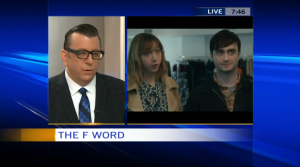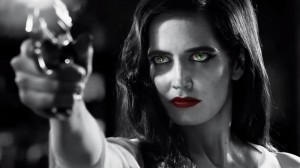RICHARD’S NAUGHTY AND NICE LIST PART ONE: THE WORST MOVIES OF 2014
 NAUGHTY LIST (in alphabetical order)::
NAUGHTY LIST (in alphabetical order)::
1.) Before I Go To Sleep: “Before I Go to Sleep,” the new Nicole Kidman movie, has a lot in common with the recent hit “Gone Girl.” Both star Academy Award winners, each feature a tall icy blonde actress in the lead role and are martial stories with an edge. The big difference between them? ”Gone Girl” is a hair-raising thriller and “Before I Go To Sleep” is not.
Based on the best-selling novel by S.J. Watson, it’s the story of Christine (Nicole Kidman), a traumatized woman who wakes up everyday with no memory. As she sleeps her mind erases itself, wiping away any new information. Her husband Ben (Colin Firth) has arranged their house as a tribute to their relationship—wedding pictures and mementoes from their life together decorate the walls—to help give her a sense of time, place and security. A neuropsychologist (Mark Strong) is secretly working with her to reassemble the shards of her memory, but as her synapsis start firing she begins to question everything about her life.
It’s the stuff of a solid thriller. “Memento,” “The Bourne Identity” and “Spellbound” have all masterfully mined similar material with more success. Director Rowan Joffe has made a stylish looking movie but allows it to get bogged down by repetition and too-tame performances. It’s a shame because the twist—and you know there has to be a twist—works well enough and there are a few tense moments in the climax but the preposterous denouement wipes away any good will the film’s exciting-ish apogee offered.
2.) I, Frankenstein: An unholy mix of religion, martial arts (Adam has some slick Bruce Lee moves) and Mary Shelley, “I, Frankenstein” should have been called “Aye, yi, yi, Frankenstein.”
There is some cool gothic Gargoyle imagery on display and a variety of posh English accents to class to the joint, but it seems only Nighy realizes that this would have played better as a campy comedy.
In amongst the over earing narration, dropped storylines—for instance, a bride for Adam is mentioned and then never mentioned again—and shots of Adam peering around corners, every now and again someone will say, “I think your boss is a demon prince.”
Mel Brooks would have known how to stage that line. For all its atmosphere—i.e.: darkly shot scenes—“I, Frankenstein” would have been a lot more fun if it embraced its silly side just as Adam must embrace his humanity. With humanity comes a sense of humor, right? Not in this case. The movie plays like a satire of bad horror movies that forgot it was a satire.
3.) Left Behind: “Left Behind” stars Nicolas Cage and sets much of the action on board a plane, but make no mistake, this isn’t “Con Air.” Instead of raising hell, Cage is playing it pious in a remake of a Kirk Cameron movie about the rapture.
Based on a popular book series about the rapture by Tim LaHaye and Jerry B. Jenkins, “Left Behind” is a mainstream reboot of a successful string of Christian movies. Directed by Vic Armstrong, the legendary stunt man best known for the “Indiana Jones” movies, the new “Left Behind” has a distinct b-movie feel, with flimsy sets and bad dialogue (“Either I’m going crazy or the whole world is insane!”) but it does feature something rather remarkable—a subdued performance from Cage. Lately he’s been a practitioner of something he calls Nouveau Shamanic school of acting but here he has dialed it way down perhaps out of respect to the religious nature of the material, or perhaps he’s saving the wild stuff for “Con Air 2: This Time it’s Biblical.”
4.) The Nut Job: “The Nut Job” is an original story that feels Frankensteined together from other, better kid’s movies. Echoes of “Ice Age” style slapstick and “Ratatouille” situations and even “Animal Farm” ethos reverberate throughout. I’ll give the filmmakers credit for adding in the gangster twist and some jazzy music but it’s the characters themselves that really disappoint.
To give you an idea of the amount of thought put into the characters, let’s start with their names. Neeson’s raccoon character is inventively named Raccoon, the rat sidekick is Buddy (Robert Tinkler) and the surly squirrel is, of course, called Surly.
Different names wouldn’t have made this a better movie, but the literal names display a lack of inventiveness that permeates the entire film. The animation is fine, but the rest—the story, the voice work, the action—feels as uninspired as peanut butter without jam.
There is very little joy, almond or otherwise, in “The Nut Job.”
5.) Night at the Museum: Secret of the Tomb: Unless the movie is called “Planet of the Apes” its faint praise to say the monkey is the best thing about a picture. Such is the case with “Night at the Museum: Secret of the Tomb,” the third outing in the popular Ben Stiller kid’s franchise. Crystal the Monkey as Dexter a Capuchin monkey, gets the most laughs and is the only member of the top-of-the-line cast who doesn’t feel like they’re only in it for the big holiday movie paycheque.
“Night at the Museum: Secret of the Tomb” beats the original premise into submission, blowing up the idea of a secret nightlife at the museum into the best example this year of how franchise filmmaking can go horribly wrong. Like the dimming tablet that slows down the wax exhibits, this movie sucks the life out of once interesting characters, placing them in a plot that is essentially an excuse to showcase more characters (like Dan Stevens as Sir Lancelot and a surprising and rather charming cameo from a very big star) and bigger special effects than in parts one and two.
6.) Sex Tape: Any movie with the word sex in the title and Cameron Diaz in her underwear and a newly slim Jason Segel in the all-together should be a lot sexier than “Sex Tape” is. The first twenty minutes plays more like an attempt to break the world record for using the word “sex” in a movie than an actual story. They talk about sex, have sex, then talk about it some more, but rather than being racy or slap-your-thigh funny it becomes tiresome. The only word used more often is “iPad,” which is even less provocative.
At one point in the film Diaz talks about her love of porn, but adds she doesn’t watch it anymore because, “the quality of the writing has gone down hill. I like it when they really feel like they’re in love.” She might have been talking about her own movie.
7.) Sin City: A Dame to Kill For: “Sin City” A Dame to Kill For” feels like it was made by someone with an eye for the aesthetics of noir but the interests of a 14-year-old boy. It’s an exercise in style over substance that will make your corneas tingle, tickle your prurient side and provide an experience that may be memorable (especially if you are a fourteen year boy) but not particularly rewarding.
These unendingly grim crime stories aren’t so much hard-boiled as they are over-baked. Rodrigues and Miller’s outlook is as bleak as the stark black-and-white palette they use to illustrate the movie. “Death is just like life in Sin City,” they say, hammering the point home that the only relief from the ennui many of these characters live with is a bullet to the head. The characters seem to welcome it. “He’ll eat you alive,” a bartender tells Johnny about the senator. “I’m a tough chew,” he replies, playing chicken with his life.
The directors try to distract from the cynical goings on with hyper-German Expressionist cinematography and Eva Green’s wardrobe, or lack thereof, but no matter how much style or skin are exposed, “Sin City: A Dame to Kill For” remains a slickly styled exercise in pointlessness.
8.) Tammy: The last time Susan Sarandon went on a cinematic road trip she was teamed with Geena Davis in a film that reinvented the buddy picture and earned praise from critics who called it a “neo-feminist road movie.”
This time out the Sarandon shares the front seat with Melissa McCarthy. Where “Thelma & Louise” learned about loyalty and sisterhood, Tammy and Pearl only pick up tips about drinking and driving, how to rob restaurants and how to destroy a jet ski.
Road movies are episodic by nature. Their stories move from place to place, from character to character, all bound by a theme. Unfortunately “Tammy” simply moves slowly from scene to scene, content to rely on McCarthy’s comedic appeal at the sacrifice of anything more than pratfalls and awkward humor.
In other words “Tammy” earns a laugh or two when McCarthy falls down, less so when she is standing upright, which is most of the movie.
9.) Transcendence: “Transcendence” asks some interesting questions. Can technology provide some sort of life after death? Does artificial intelligence offer more promise or peril? How much humanity can a computer program possess? Is “Her” a better movie about love in the computer age?
The questions are interesting and might have been thought provoking if “Transcendence” was a better movie. Director Wally Pfister (best known as Christopher Nolan’s DOP of choice) and screenwriter Jack Paglen tackle big questions head on, but in the most perplexing of ways. Weird tonal shifts from sci fi to cyber love to techno terrorism make for a drearily paced film. Add to that unclear character motivations—MILD SPOILER ALERT: exactly who’s side is Max on?—and an underdeveloped love story and you’re left with a film that brims with promise but underwhelms.
So too does Johnny Depp. You have to cut him some slack because for 90% of the film he only appears on computer screens, doing his best HAL impression, but he seems to have checked out long before his character does. Hall and Bettany do some soulful work, but are hampered by a love story that is more about code than contact.
“Transcendence” has style, and it should, Pfister (who used DOP Jess Hall on this film) is a gifted shooter who gave us one of my favorite shots of recent years—The Joker hanging out of the cop car in “The Dark Knight,” surrounded by blurred lights and city scape. Given the choice I’d choose to watch that thirty seconds again and again over spending one more minute in the lackluster world of “Transcendence.”
10.) Winter’s Tale: What is meant to be an uplifting experience about the power of love and the triumph of good over evil felt more like being strapped to a chair and force-fed all nine seasons of “Touched by an Angel.”
Based on the best-selling novel of the same name by Mark Helprin and brought to the screen by Oscar winning writer-turned-director Akiva Goldsman the story begins when Peter Lake (Colin Farrell), a turn-of-the-last century burglar, comes across the love of his life while robbing a mansion he thought was empty.
Beverly Penn (Downton Abbey’s Jessica Brown Findlay) the beautiful-but-doomed daughter of a wealthy newspaper tycoon, is a precocious and philosophical young woman with just months to live. He wants to save her, but first he must save himself from demonic crime lord Pearly Soames (Russell Crowe), a brutal man who wants Lake dead. Then, in a twist suggested by the Brothers Grimm, he finds himself thrust one hundred years into the future with only the faded memory of Beverly and a white guardian angel horse as company.
As silly as the movie is, and make no mistake, this is what I like to call an S.D.M.—Silly Damn Movie—Farrell and Findlay manage to bring the romantic side of the tale alive. Their first meeting, over a cup of tea, is simple, effective and bristles with sexual tension. The love story, although a bit starry-eyed, works until the magic realism takes over and the story becomes loopier and loopier. By the time the words, “Is it possible to love someone so much they can’t die?” spill from Farrell’s lips all is lost, and that’s not even an hour into the story.
Putting aside the enchanted horses and dime store spirituality for a moment, the story often requires leaps of faith that would have even terrified Evel Knievel. This is the kind of movie where mothers willingly hand over their sick children to scruffy looking strangers on the promise of a miracle. It’s the kind of movie where people accept outlandish events with a tossed off phrase like, “How’s that even possible?” It’s the kind of sloppily plotted movie that involves a level of suspension of disbelieve so off-the-charts it’s almost in outer space.





